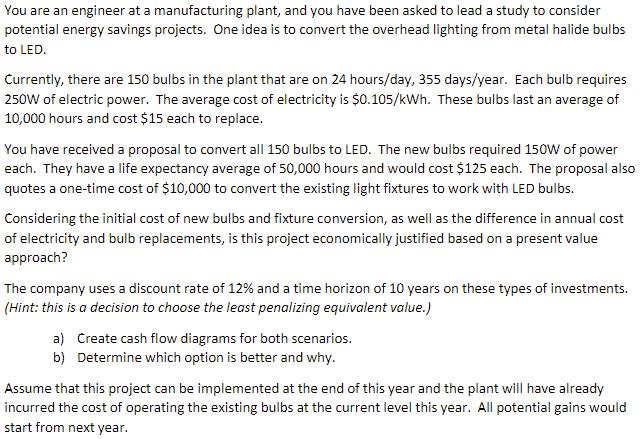
You are an engineer at a manufacturing plant, and you have been asked to lead a study to consider potential energy savings projects. One idea is to convert the overhead lighting from metal halide bulbs to LED. Currently, there are 150 bulbs in the plant that are on 24 hours/day, 355 days/year. Each bulb requires 250W of electric power. The average cost of electricity is $0.105/kWh. These bulbs last an average of 10,000 hours and cost $15 each to replace. You have received a proposal to convert all 150 bulbs to LED. The new bulbs required 150W of power each. They have a life expectancy average of 50,000 hours and would cost $125 each. The proposal also quotes a one-time cost of $10,000 to convert the existing light fixtures to work with LED bulbs. Considering the initial cost of new bulbs and fixture conversion, as well as the difference in annual cost of electricity and bulb replacements, is this project economically justified based on a present value approach? The company uses a discount rate of 12% and a time horizon of 10 years on these types of investments. (Hint: this is a decision to choose the least penalizing equivalent value.) a) Create cash flow diagrams for both scenarios. b) Determine which option is better and why. Assume that this project can be implemented at the end of this year and the plant will have already incurred the cost of operating the existing bulbs at the current level this year. All potential gains would start from next year. You are an engineer at a manufacturing plant, and you have been asked to lead a study to consider potential energy savings projects. One idea is to convert the overhead lighting from metal halide bulbs to LED. Currently, there are 150 bulbs in the plant that are on 24 hours/day, 355 days/year. Each bulb requires 250W of electric power. The average cost of electricity is $0.105/kWh. These bulbs last an average of 10,000 hours and cost $15 each to replace. You have received a proposal to convert all 150 bulbs to LED. The new bulbs required 150W of power each. They have a life expectancy average of 50,000 hours and would cost $125 each. The proposal also quotes a one-time cost of $10,000 to convert the existing light fixtures to work with LED bulbs. Considering the initial cost of new bulbs and fixture conversion, as well as the difference in annual cost of electricity and bulb replacements, is this project economically justified based on a present value approach? The company uses a discount rate of 12% and a time horizon of 10 years on these types of investments. (Hint: this is a decision to choose the least penalizing equivalent value.) a) Create cash flow diagrams for both scenarios. b) Determine which option is better and why. Assume that this project can be implemented at the end of this year and the plant will have already incurred the cost of operating the existing bulbs at the current level this year. All potential gains would start from next year







